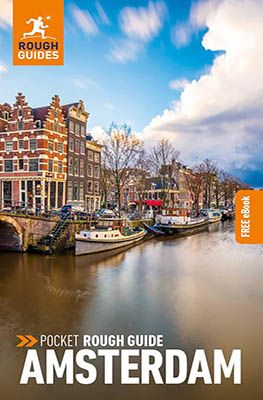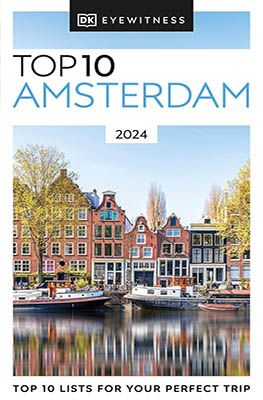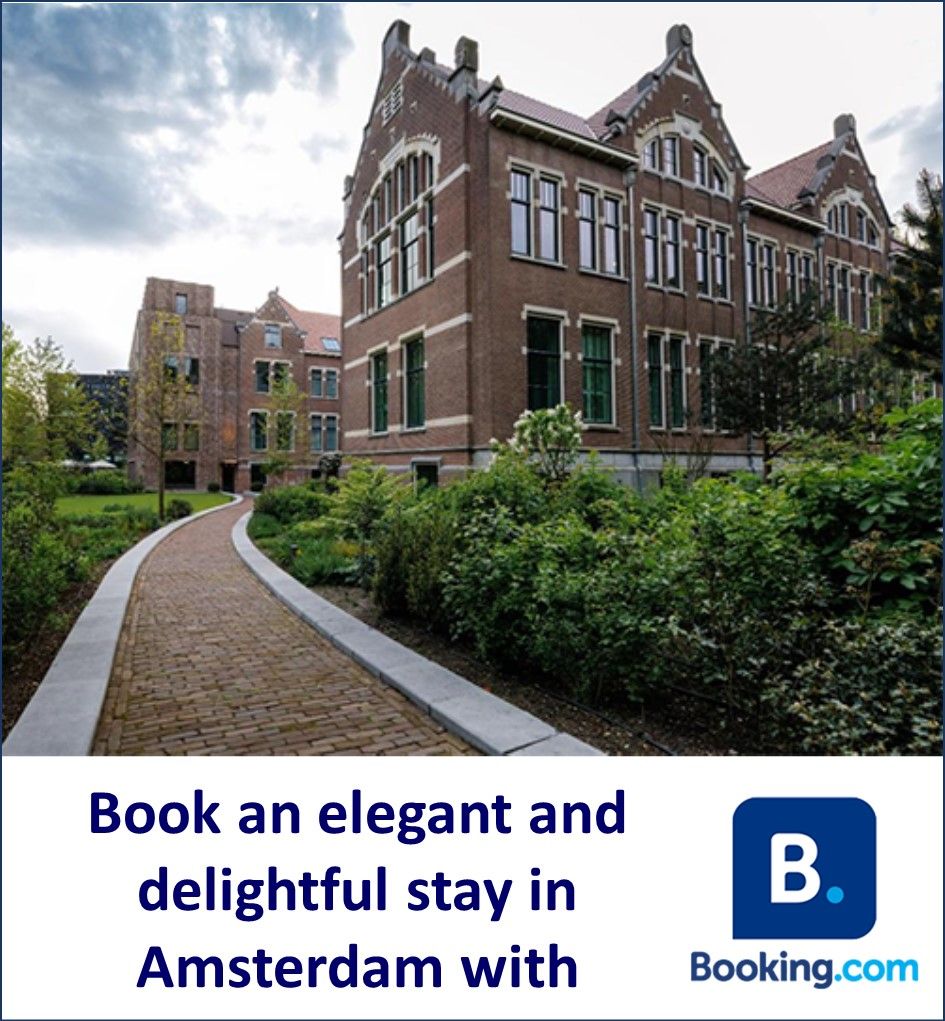Navigating the Amsterdam canals with an Eco Boat
Navigating the Amsterdam canals with an Eco Boat
The Dutch capital, Amsterdam, is renowned for its iconic canals. Sailing through these canals provides a unique way to admire the city. From the water, you get a completely different perspective on the architecture, history, and city life. It remains special to explore the city from the water. Without a boating license, it is possible to rent an electric sloop for an eco-friendly boating trip. Because with an Eco Boat, you sail silently through the canals of Amsterdam.
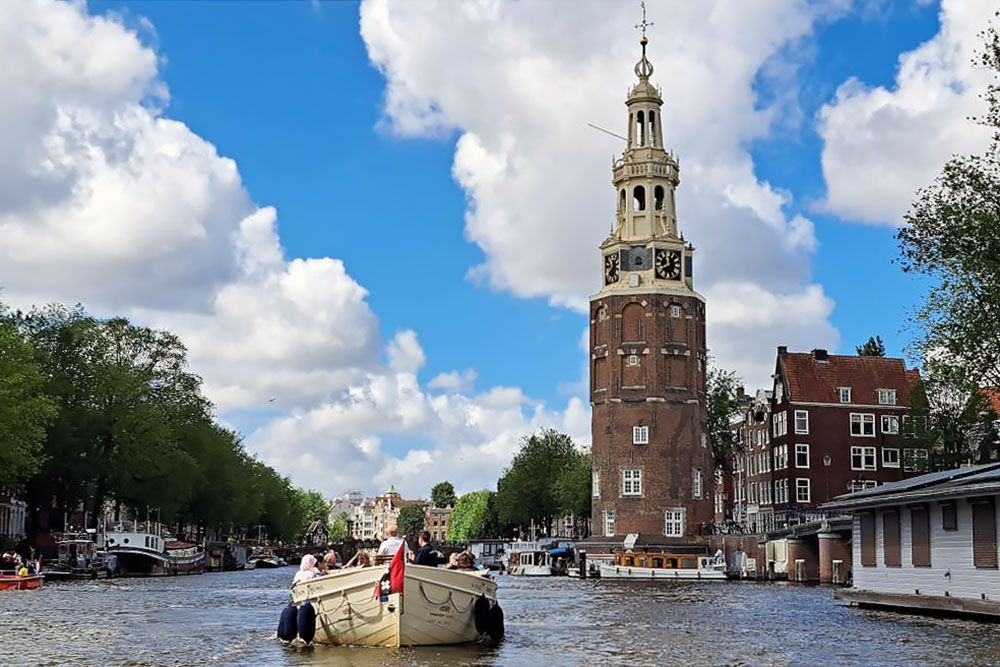
The unique perspective of the Amsterdam canals
The Amsterdam canals form a network of approximately 100 kilometers of waterways, with over 1500 bridges and nearly 90 islands. These canals (“grachten” in Dutch) are not only practical for transportation and water management. They also provide a beautiful backdrop for a relaxing boat trip. For good reason, the unique canal belt of Amsterdam is listed as a UNESCO World Heritage Site. The 17th-century canals, with their stately merchant houses and picturesque bridges, form the beating heart of the city.
From the water, you see the city in a way that is not possible on foot or by bike. You can sail past the most beautiful canal houses, enjoy the beautiful facades, and sail under the characteristic bridges. The view is breathtaking everywhere. With a whisper-quiet, electric Eco Boat, it’s a double delight: without noise, diesel fumes, and vibration, you sail environmentally consciously through the water. And a boating license is not required to rent such a sloop. We wanted to try that too.
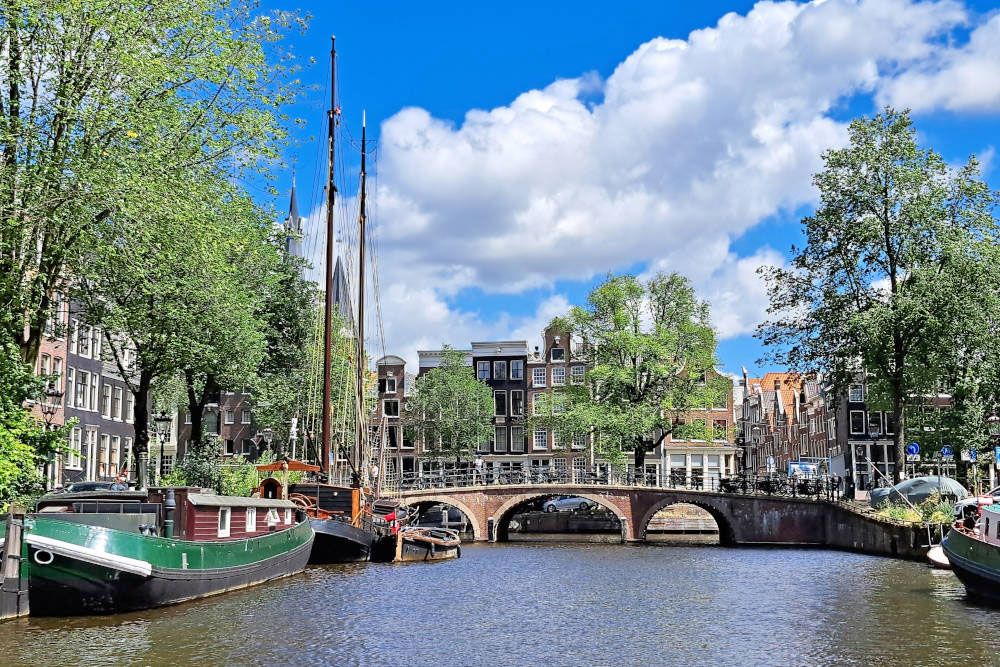
Navigating the Amsterdam canals with the Eco Boat
We report to the Eco Boats Amsterdam rental location at 10 o’clock. The staff member promptly takes us to the sloop. He provides clear instructions, suggests beautiful routes, and goes over the boating rules with us. We had already read them on the website as preparation, but it never hurts to hear them again. Operating the Eco Boat is remarkably straightforward. With the lever, we can regulate the speed and put the boat in reverse. It’s a piece of cake. Cast off, and we set sail.
Eco Boats Amsterdam has provided us with a map. It also includes two sample routes. We decide to take it easy by combining these two routes, which, according to the staff member, will keep us busy for about three hours.
We make the outing even more enjoyable and environmentally friendly by “plastic fishing” while sailing. Plastic fishing is an activity where you collect waste from the canals to keep the waterways clean. Armed with nets and a large garbage bag, we set sail. This way, we contribute to a cleaner environment in the Amsterdam canals in two ways: we navigate the canals with an Eco Boat and keep them clean.
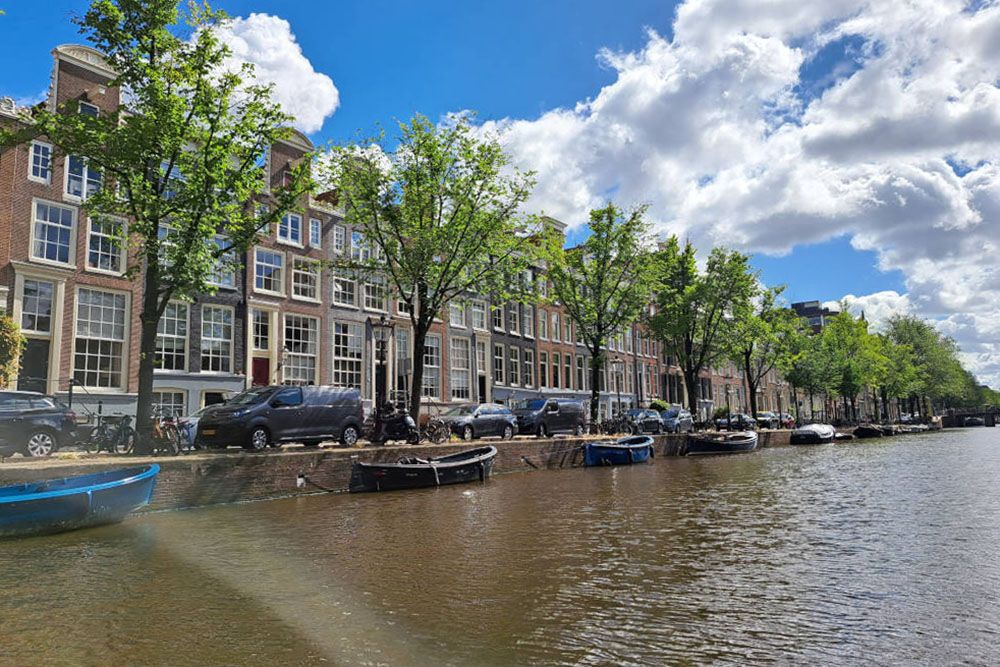
Prinsengracht
From the Westerdok, we sail onto the Prinsengracht. Thanks to the one-way traffic in force here, we don’t have to worry about oncoming traffic. Quite relaxing. This gives us all the time to enjoy the Noordermarkt, the stately canal houses with their richly decorated facades, and the much-sung Westertoren at the Westerkerk. Due to restoration, the tower is wrapped in large green cloths. Hopefully, the Westertoren will be back in all its glory by 2025.
Many houseboats line the quay. From the water, we have a beautiful view of all these floating homes. There are remarkable creations among them. Some are floating museums, such as the houseboat museum. The houseboats are not affected by the wake as we sail by. The Eco Boat is not fast and therefore does not cause waves on the water.
Just before we reach the Amstel, we pass the Amstelveld and the Amstelkerk. It’s bustling, as there’s a market going on. We now leave our “Royal Route” and make a crossing over the Amstel to the “Artis Route.”
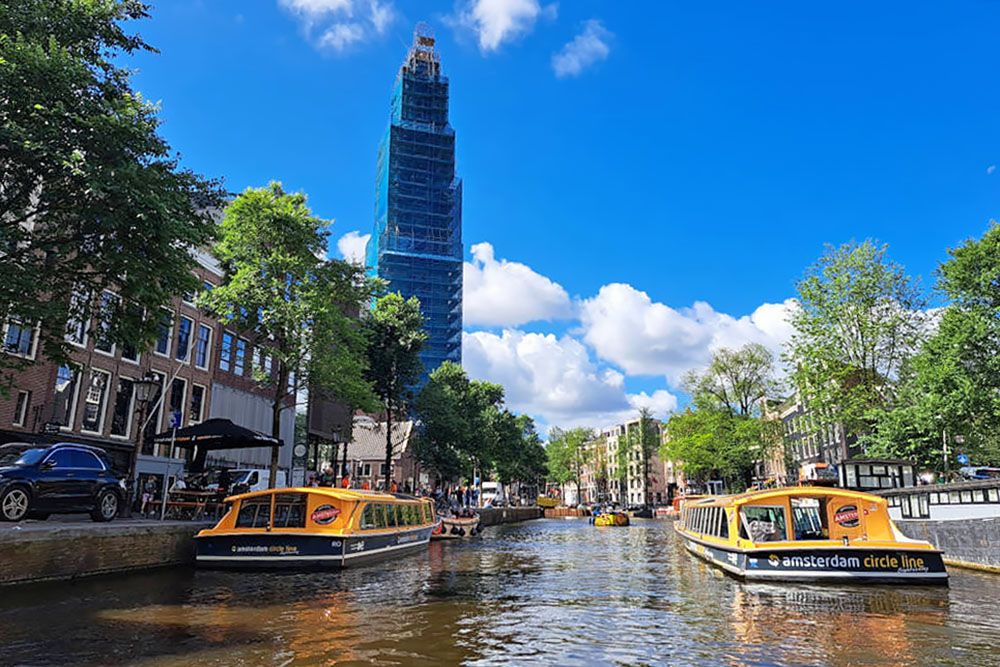
Magere Brug
To our left, we see the Magere Brug, a national monument. This bridge spans the Amstel and has served as a backdrop in many films, such as the James Bond film “Diamonds are Forever”. The Magere Brug (literally “skinny bridge” in English) has a name that captures the imagination. According to legend, the Mager sisters built the bridge. That story is a fairy tale. The bridge was initially very narrow. To pass each other, one had to be slim or skinny. This quickly gave the bridge its name. And now, the Magere Brug is an iconic attraction in the city. It is the most photographed bridge in Amsterdam.
On the right, the view is equally beautiful. At the level of the Amstel locks lies Theater Carré, and a little further the elegant Amstel Hotel. Magnificent monumental buildings, which show even more grandeur from the water.
The Artis Route is exceptionally peaceful; we hardly encounter any other boats. Yet, this is a delightful route with many attractions. The first thing that catches our eye is a stork feeding its young. The nest is made on top of a chimney, right in the middle of the city. A remarkable spot to build a nest.
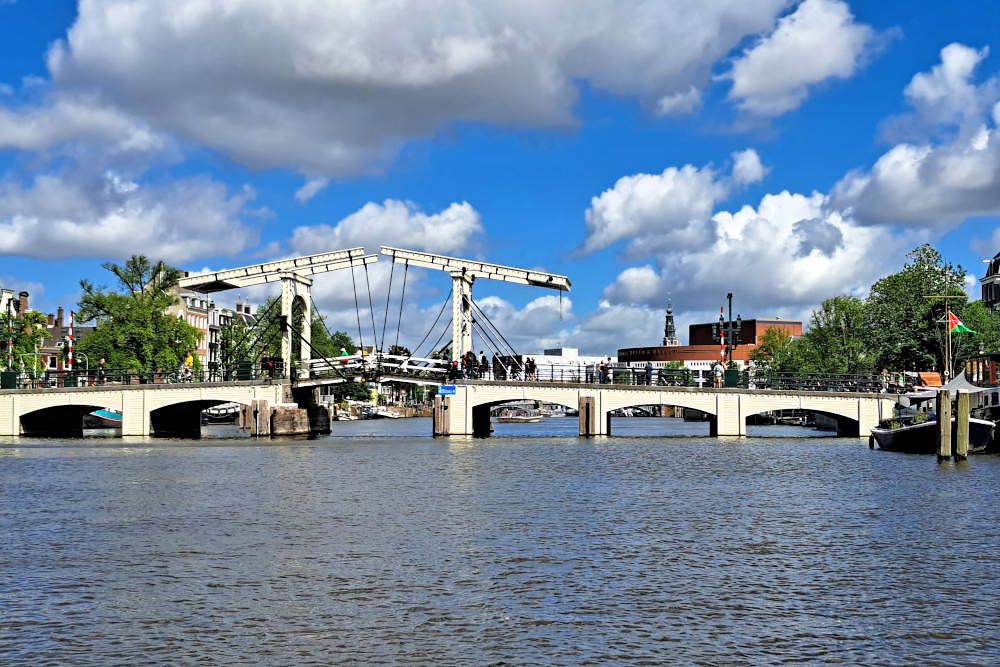
Shipyard ‘t Kromhout
On the Plantage Muidergracht, we sail around the grounds of Artis, the oldest zoo in our country. First past the monumental wooden buildings, later past the new grounds and enclosures created in recent years. On the other side of the water are the old warehouses of the Entrepotdok. They have since been converted into apartments. The Entrepotdok is the largest inhabited warehouse complex in the city. In the distance, the only remaining crane, which recalls the bustling past of the Entrepotdok, towers above the trees.
We sail through the Entrepotdok lock to reach the Nieuwe Vaart along the Wittenburgergracht. On the corner lies Museum ‘t Kromhout, a shipyard and former engine factory. The yard was already in operation in the mid-18th century. Kromhout also produced diesel engines, not only for ships but also for buses and trucks. The yard is still in use. The other hall is now arranged as a museum.
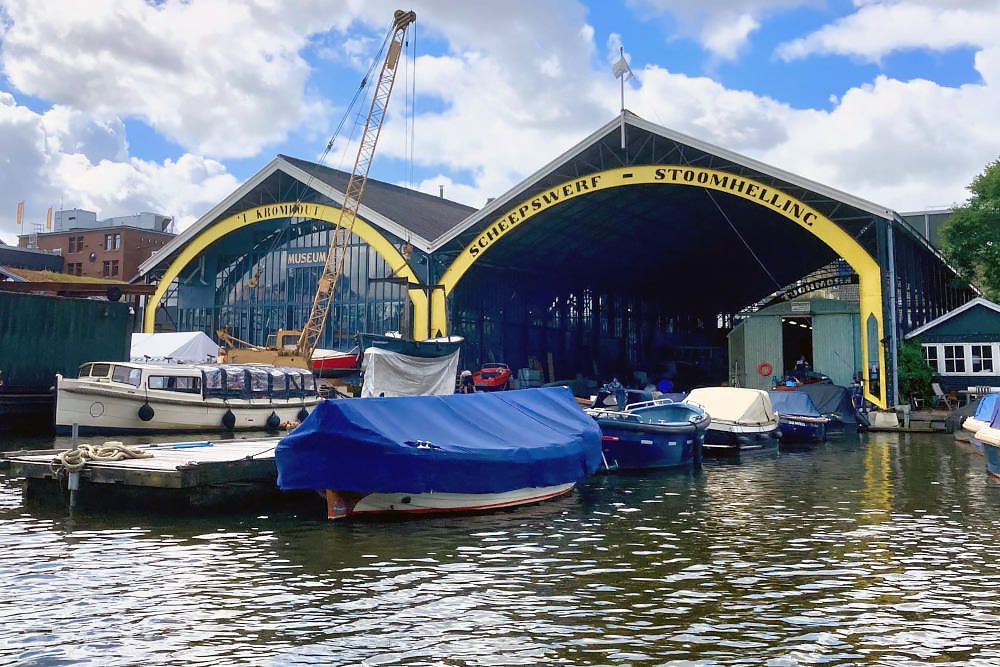
Scheepvaartmuseum and NEMO
After sailing under the bridge of the Prins Hendrikkade, a splendid panorama unfolds. To our right is the imposing building of the Scheepvaartmuseum (Maritime Museum). From the water, the structure is even more impressive than from the shore. Behind it lies the replica of the VOC ship “Amsterdam”. A little further away, the building of the NEMO Science Museum emerges. The copper-green building appears as a ship rising out of the water. Visitors to the museum walk on the sloping roof, enjoying a beautiful view of the city. We sail around the Nemo building. We have never admired the rear of it in this way before. The sight pleases us greatly.
From now on, it becomes busier on the water. We sail together with various tourist-filled tour boats onto the Oosterdok. At the narrow bridges on the Oudeschans, we regularly pull over to the side. This way, the tour boat does not have to slow down for our boat as we pass under a narrow bridge. A nod of approval from the captain and a hearty wave of his hat is our reward.
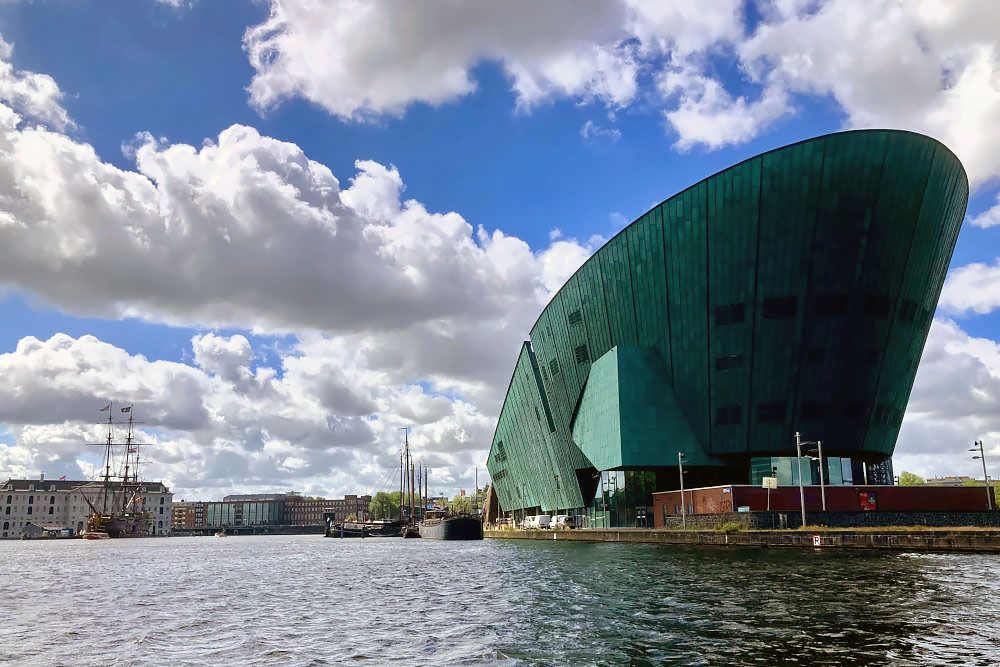
Most beautiful view of Amsterdam
Via the Zwanenburgwal, we reach the Stopera, the city hall, and the music theatre. Nearby lies the Blauwbrug, another striking bridge in the city. It has the grandeur of the bridges you see in Paris. It’s not blue, it used to be. Now, only the blue lanterns remind us of those times.
Our attention is particularly drawn to the beautiful view on our right. We look out over the Amstel, the beautiful canal houses on the quay, and the Halvemaansbrug. Beyond that, we discern the luxury hotel De l’Europe. In the background, the Munttoren dominates the scene. This tower was once part of the city gate in the medieval fortifications of the city. The tower has a carillon with over 20 bells. Every Saturday afternoon, the city carillonneur gives a concert on this carillon.
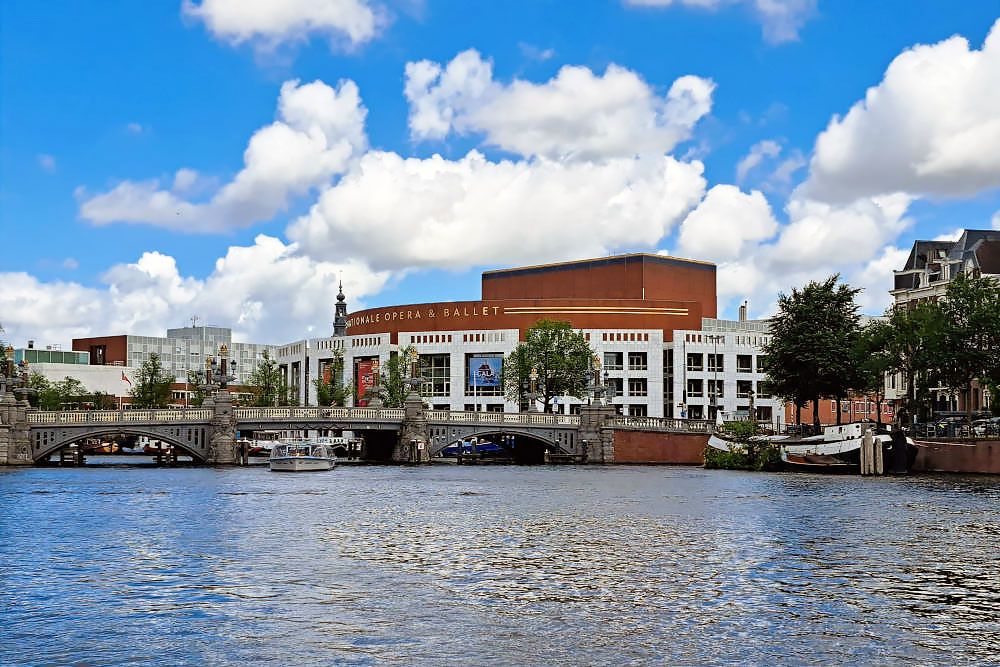
Just before the Magere Brug, we leave the Amstel behind. We now pick up the “Royal Route” again and continue sailing along the Keizersgracht. There, we encounter heavy traffic. A large group of students, divided over 10 pedal boats, pedals through the water. As we overtake them, we hear them say that they’d rather be in a whisper-quiet Eco Boat. They find it much more relaxing than the energy-draining pedal boat. Fortunately, the Keizersgracht is the widest canal in the city. This makes it easy for us to maneuver around the pedal boats.
Along the Keizersgracht, we encounter once again stately canal houses, churches, and museums. We sail past the Museum Van Loon, the FOAM photography museum, Huis Marseille, the Keizersgrachtkerk, Felix Meritis, the Rode Hoed, and the Onze-Lieve-Vrouwekerk. A little further, we pass the Homomonument. The monument consists of three pink, granite triangles. Together, they form a large triangle. It serves as a memorial to all homosexual men and women who have been persecuted because of their sexual orientation.
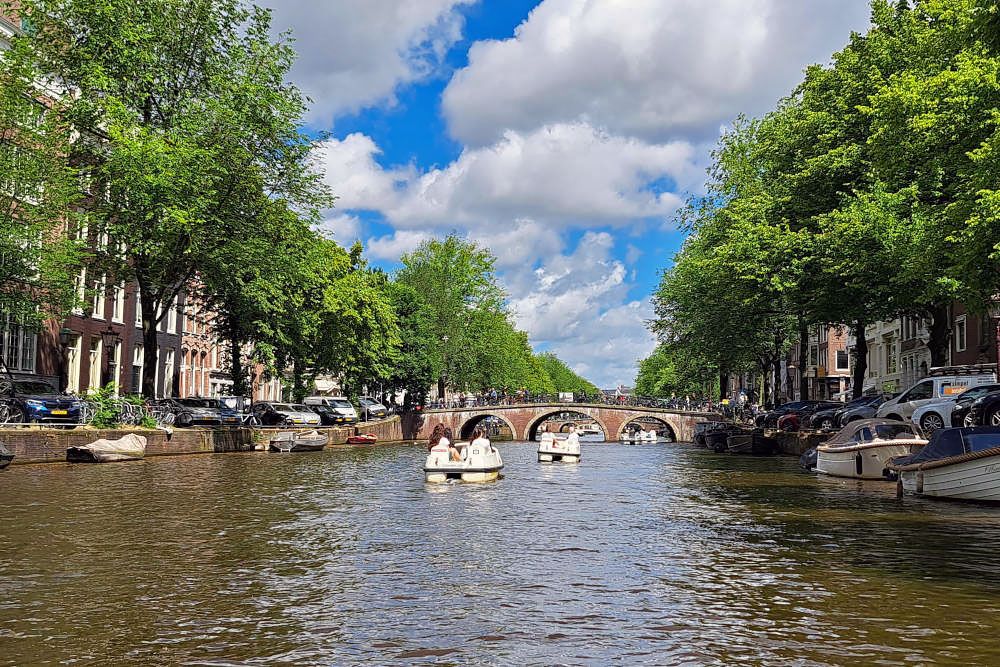
Blockade
We noticed all morning that work is being done on the bridges and quays. It turns out that they are in poor condition due to overdue maintenance. Therefore, the municipality is now engaged in a large-scale restoration operation. We fully realize this when we want to sail onto the Brouwersgracht. Large pontoons completely block the access. We have no choice but to go back onto the Prinsengracht for a while. Due to the one-way traffic, we can only go in the direction of the Amstel. Via the Egelantiersgracht, we end up on the Lijnbaansgracht. This way, we sail back to the north.
Things get a bit exciting there. We have to pass under a low bridge. Fortunately, I’ve gained a few kilos lately, otherwise, we would have had to take ballast on board. Lying flat, we carefully slide under the bridge; it just fits!
Via the Zoutkeetsgracht, we sail back to Eco Boats Amsterdam. We moor the boat and step off with a bag full of plastic waste. The three hours on the water have flown by. The fact that we also had a delightful sun now and then made the boating trip complete.
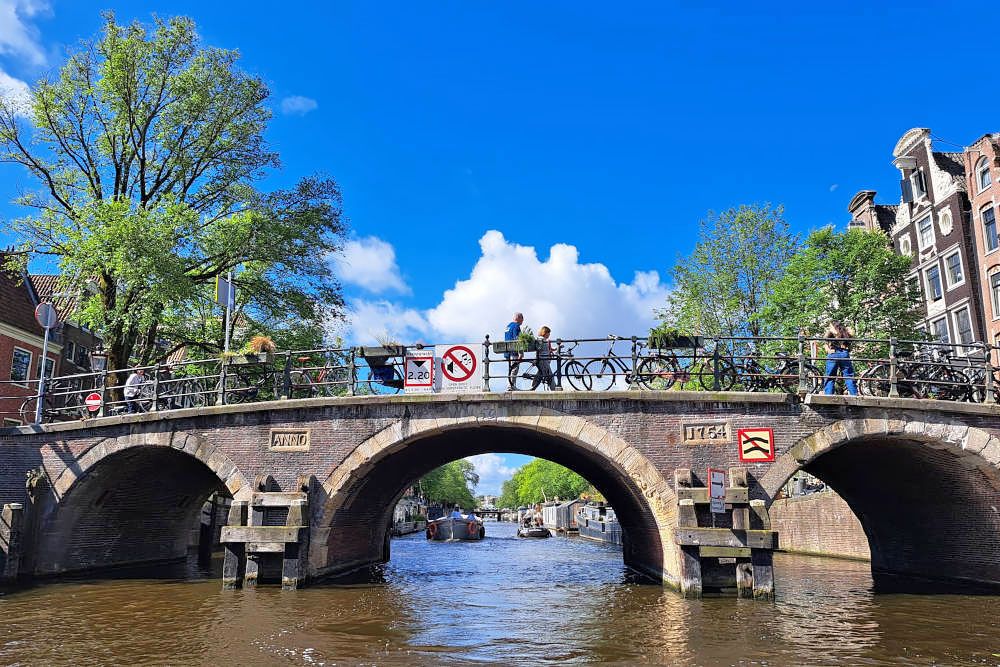
Our experiences with an Eco Boat
Eco Boats Amsterdam did everything to make our boating trip a success. In advance, we received a confirmation via email, along with an explanation of the boating rules. At the pickup location, we received clear instructions on how to operate the boat and a suggestion for a fun boating route.
Operating the boat was child’s play. Besides steering and occasionally slowing down, there’s not much to do. The electric motor doesn’t have much power, which ensures that you sail through the canals at a relaxed speed. The sloop is spacious and can accommodate 8 to 12 people (depending on the type of sloop you book). We sailed with just the two of us. We can imagine that with a full capacity, the motor might need a bit more power.
The biggest plus point for us was the whisper-quiet electric motor. Not only environmentally conscious but also very soothing. Three hours of sailing in a vibrating boat with a smoky diesel engine sounds much less appealing. During our boating trip, we also received regular compliments from houseboat residents: “Nice and quiet, well done.”
All in all, we had a few delightful hours on the water. We highly recommend boating with an Eco Boat. You’ll enjoy a whisper-quiet cruise through a unique canal area. This is Amsterdam at its most beautiful!
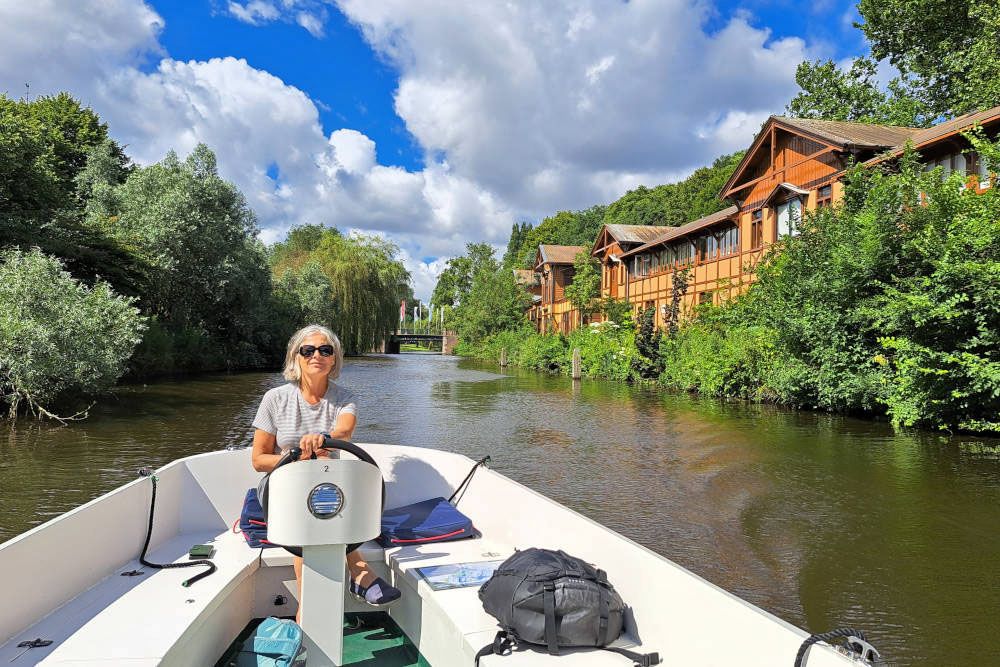
Practical questions about boating with an Eco Boat in Amsterdam
No, you do not need a boating license to sail with an Eco Boat in Amsterdam. Anyone 18 years and older is allowed to operate the boat.
That's entirely up to you. You can rent a boat from one hour to a full day. We sailed for three hours and gained a good understanding of the canal belt in the city center and the tranquil, yet equally beautiful sailing area around Artis.
Make sure to bring the booking confirmation and identification. Check the weather forecast for that day and dress accordingly. When it's sunny, be sure to bring a cap or hat and sunscreen. It's also useful to bring some food and drinks on board.
All the canals in Amsterdam are beautiful. However, be aware that some sections can be busy, even with tour boats. These boats always have priority. In addition, some canals have one-way traffic. Strictly adhere to this, as the fines are hefty. Eco Boats Amsterdam has already selected some beautiful routes for you. You can find them on the map you receive when picking up the boat.
Indeed, there are boating rules on the canals in Amsterdam. Some canals have one-way traffic. Commercial transport and tour boats always have the right of way over pleasure craft. These are the most important boating rules in Amsterdam.
You can hire an Eco Boat from Eco Boats Amsterdam. You pick up your boat at the dock at Zandhoek 22, in the city center. It's a 20-minute walk from Amsterdam Central. You can also take bus 48 from Amsterdam Central. Get off at the Barentszplein stop.
We made this canal tour through the Amsterdam canals at the invitation of Eco Boats Amsterdam. The content of the blog was independently and objectively compiled based on our own impressions.

